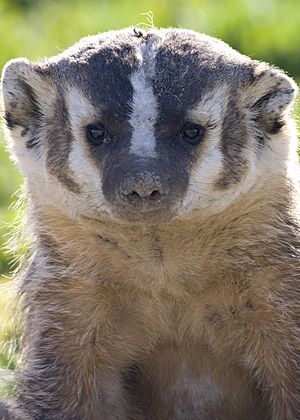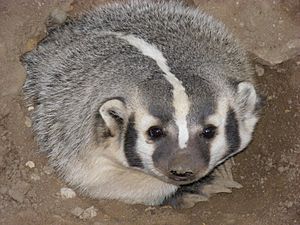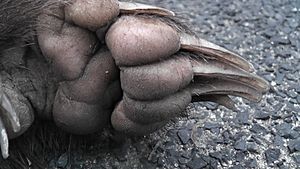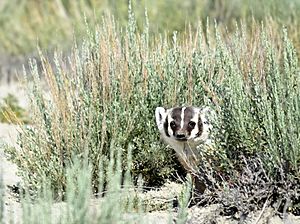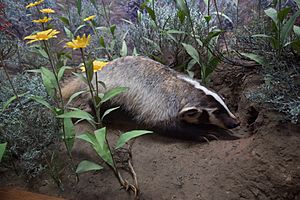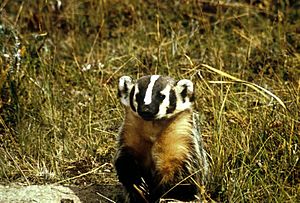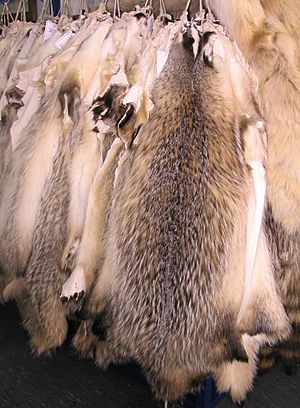American badger facts for kids
Quick facts for kids American badger |
|
|---|---|
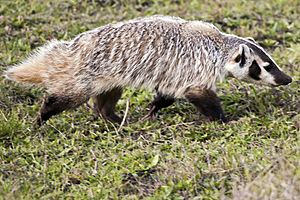 |
|
| In Point Reyes National Seashore, California | |
| Conservation status | |
| Scientific classification | |
| Genus: |
Taxidea
|
| Species: |
taxus
|
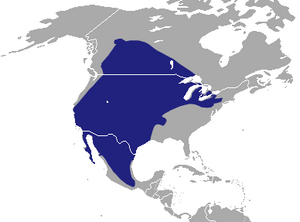 |
|
| American badger range | |
The American badger (Taxidea taxus) is a type of badger found in North America. It looks a bit like the European badger, but they are not very closely related. You can find American badgers in the western and central United States, northern Mexico, and parts of south-central Canada.
These badgers usually live in open grasslands. They like areas where they can find prey easily, such as mice, squirrels, and groundhogs. They prefer places like prairies with sandy soil, which makes it easier for them to dig for food.
Contents
About the American Badger
American badgers have a strong, low-to-the-ground body. They have short, powerful legs. You can easily spot them by their huge front claws, which can be up to 5 centimeters (about 2 inches) long! They also have special markings on their heads.
These badgers are usually between 60 and 75 centimeters (24 to 30 inches) long. Male badgers are a little bigger than females. Females usually weigh about 6.3 to 7.2 kilograms (14 to 16 pounds). Males can weigh up to 8.6 kilograms (19 pounds). In the fall, when there is lots of food, male badgers can get even heavier, up to 11.5 to 15 kilograms (25 to 33 pounds).
Most of the American badger's body is covered in coarse hair. It's a mix of brown, black, and white, which makes it look like a mixed brown-tan color. This coat helps them blend in with the grassland around them. Their face is shaped like a triangle and has clear black and white patterns. They have brown or black marks on their cheeks. A white stripe goes from their nose all the way to the back of their head.
What American Badgers Eat
The American badger is a carnivore that loves to dig. This means it eats meat and uses its strong claws to dig for its food. They mostly hunt small animals that live underground. These include pocket gophers, ground squirrels, moles, prairie dogs, and voles. Badgers often dig into the dens of these animals to catch them. Sometimes, they even block the tunnel entrances with objects!
American badgers are also important predators of snakes, including rattlesnakes. In South Dakota, they are considered the most important animal that hunts rattlesnakes.
They also eat birds that nest on the ground, like the bank swallow and burrowing owl. Their diet can include lizards, amphibians, and even dead animals (carrion). Sometimes, they eat fish, skunks, insects like bees, and even honeycomb. They might also eat some plants like corn, peas, green beans, mushrooms, and sunflower seeds.
Badgers are usually active at night. However, in quiet areas where people don't bother them, you might see them looking for food during the day. Badgers do not truly hibernate in winter. But they do become less active. They might spend much of the winter in short periods of deep sleep called torpor, which can last about 29 hours. They will come out of their burrows when the weather gets warmer, above freezing temperatures.
Life of a Badger
Badgers are usually solitary animals, meaning they live alone. But during the breeding season, they might travel more to find a mate. They mate in the late summer and early fall. Baby badgers are born from late March to early April. A mother badger usually has one to five young, with about three being common. Most female badgers have their first babies after they are one year old. Males usually don't breed until they are two years old.
When they are born, baby badgers are blind and helpless, but they have fur. Their eyes open when they are about four to six weeks old. The mother badger feeds her young solid food before they stop drinking milk. She continues to feed them for a few weeks after that. Young badgers first come out of their den on their own when they are five to six weeks old. Families usually split up, and the young badgers leave from late June to August.
Sometimes, large predators will hunt American badgers. In the wild, badgers usually live for 9 to 10 years. The oldest known wild badger lived for 14 years. A badger living in a zoo lived for at least 15 years and five months.
Where Badgers Live
American badgers prefer grasslands and open areas. This can include parks, farms, and places without many trees that have plenty of small animals for them to eat. You might also find them in forest clearings, meadows, marshy areas, hot deserts, and mountain meadows.
In Arizona, they live in desert scrub and semi-desert grasslands. In California, American badgers survive in open grasslands, including farmlands and protected areas. They can also be found in regional and state parks with grassland habitats.
In Ontario, Canada, they mainly live in the very southwestern part of the province. They are found along the north shore of Lake Erie in open areas, often near farms and woodland edges.
American badgers need places to sleep, hide, and stay safe from the weather. They often make their homes by making existing holes, like gopher holes, bigger. Their dens can be about 4 to 10 feet deep and 4 to 6 feet wide.
A female American badger might make 2 to 4 burrows with a tunnel connecting them. This helps her and her young stay hidden and safe. When a badger digs a burrow, the dirt is pushed out in front of the entrance. From a distance, the burrow looks like a mound with a hidden space underneath.
Who Hunts Badgers
The American badger is a tough animal and doesn't have many natural enemies. However, other animals in its habitat can still hunt it.
Smaller badgers have been hunted by golden eagles, coyotes, and bobcats. Bears and gray wolves sometimes kill American badgers. Cougars seem to be the main predators of adult badgers. They hunt badgers more often than other meat-eating animals.
People also hunt American badgers for their fur. Their fur is used to make brushes, like those for shaving or painting.
In May 2000, two types of American badgers in Canada were listed as endangered species. These were the Taxidea taxus jacksoni and the T. t. jeffersonii subspecies. The California Department of Fish and Game also considers the American badger a California species of special concern.
Images for kids
-
An American badger skull
-
An American badger at Omaha's Henry Doorly Zoo and Aquarium
See also
 In Spanish: Tejón norteamericano para niños
In Spanish: Tejón norteamericano para niños



